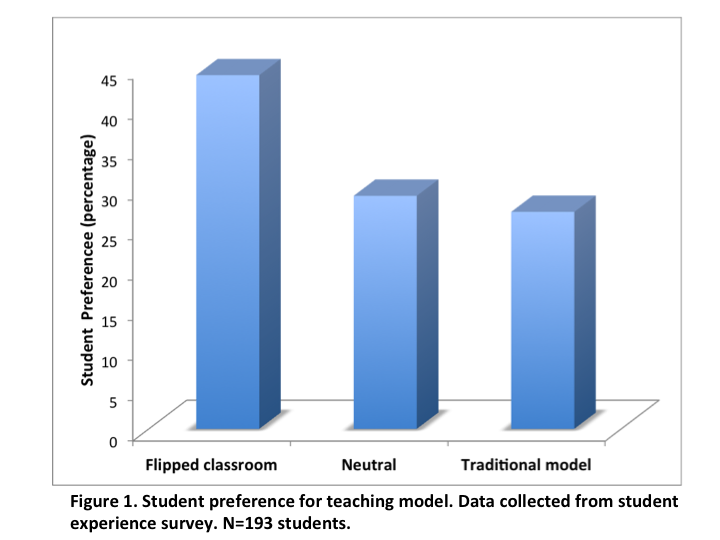ePOSTER


Abstract Title
Medical students' perceptions of 'flipped' respiratory physiology lectures


Theme
3BB The lecture and the flipped classroom
INSTITUTION
University of British Columbia - Canada
Background
- Clinical reasoning requires physicians to cognitively integrate two types of knowledge: 1) Conceptual (biomedical sciences); and 2) Problem-solving (application of concepts)1.
- The ‘flipped’ classroom is one method for integrating conceptual and problem-solving knowledge in large classrooms.
- Flipped classrooms involve pre-study of knowledge with in-class time used to apply the pre-acquired knowledge in the context of problem-solving2.
- Despite the recent popularity of the flipped classroom approach, the experiences of students are not well described in the medical education literature.
- This poster describes student experiences with flipping three traditional first-year pulmonary physiology lectures in the MD Undergraduate Program at the University of British Columbia.
Summary of Work
Pre-class learning materials:
- 3-5 voice-over-powerpoint podcasts per lecture, each 5-7 mins in length.
- Summary notes pacakge.
- Practice problem sets.
- Pre-class learning activities were limited to 25 mins or less.
- All materials were housed on an interactive website (See Details for more information).
In-class activiy:
- Active problem solving session using videoconferencing with class of ~300 students at four sites.
- Clicker-driven MCQ questions (See Details for example questions).
- 3 mins to answer the question, 5 mins for discussion.
- Team facilitated (foundational scientist and a clinican).
- A student experience survey was distributed electronically to the entire class; completed surveys were collected anonymously by the Evaulation Studies Unit.
Summary of Results
- The response rate for the survey was 57%.
Preference for teaching model:
- Overall, 44% of students preferred the flipped classroom model, 29% answered neutrally and 27% preferred the traditional lecture-based model (Figure 1).

Value and usage of pre-class learning materials:
- Despite concerns about long term “buy-in” in and student resistance to increased preparation time, 91% of our respondents agreed that the pre-class workload was reasonable.
- The majority of students (70%) reported using both podcasts and summary notes prior to the in-class. session, whereas 23% viewed podcasts only and 7% reported using notes only (Figure 2).
- 69% of respondents viewed the individual podcasts at least once before the in-class session, 28% viewed the podcasts twice, and 4% viewed the podcasts 3 or more times (Figure 3).
- Students valued the pre-class learning materials, commenting that the podcasts allowed them to learn at their own pace.
- Students appreciated having access to both podcasts and summary notes.


Value of the in-class problem solving session:
- The in-class session received mixed reviews.
- Overall, students appreciated the concept of active problem-solving but felt this was challenging in a large, multi-site lecture theatre setting.
- Some students found the calculations to be challenging in real time and requested practice problem sets prior to the sessions.
- Students perceived the in-class questions as being too focused on pure physiology. There was a universal request to increase the complexity and the clinical relevance in our questions. (See Table 1, Details).
Value of the team-taught session:
- A team-taught approach was used in the problem-solving session to promote integration.
- Most students valued the team-taught approach; particularly the different perspectives and alternative explanations. (See Table 1, Details).
- Some students felt the sessions were disjointed when delivered as a team.
Conclusion
- Students found the pre-class learning materials valuable and the workload reasonable.
- Students appreciated the opportunity to apply their physiology knowledge but requested increased complexity and more clinical relevance to the questions used in the problem-solving sessions.
- Students valued the team-taught approach.
- Overall, students preferred the flipped classroom model to traditional lectures.
Take-home Messages
- Flipped classroom experiences can help students apply basic, physiologic prinicples.
- The pre-class learning activities allow students to learn at their own pace.
- The request to increase the complexity and provide more clinical relevance to the questions should be seen as positive because it means that students are comfortable with the baseline physiologic concepts.
- Integrated team-taught approaches require coordination but are worth further exploration because students value both perspectives in the classroom.
Acknowledgement
We would like to thank Monika Fejtek for her help with the website and posting of pre-class learning materials, and Michael Davis (Educational Survey Unit, University of British Columbia) for administering the survey and collecting the data.
References
- Cohen R, Eva KW. How might mathematics education be used to improve diagnostic reasoning? Diagnosis. 2014. 1(1):135–7.
- Deslauriers L, Schelew E, Wieman C. Improved Learning in a Large-Enrollment Physics Class. Science (80). 2011;332:862–4.
 Send Email
Send Email